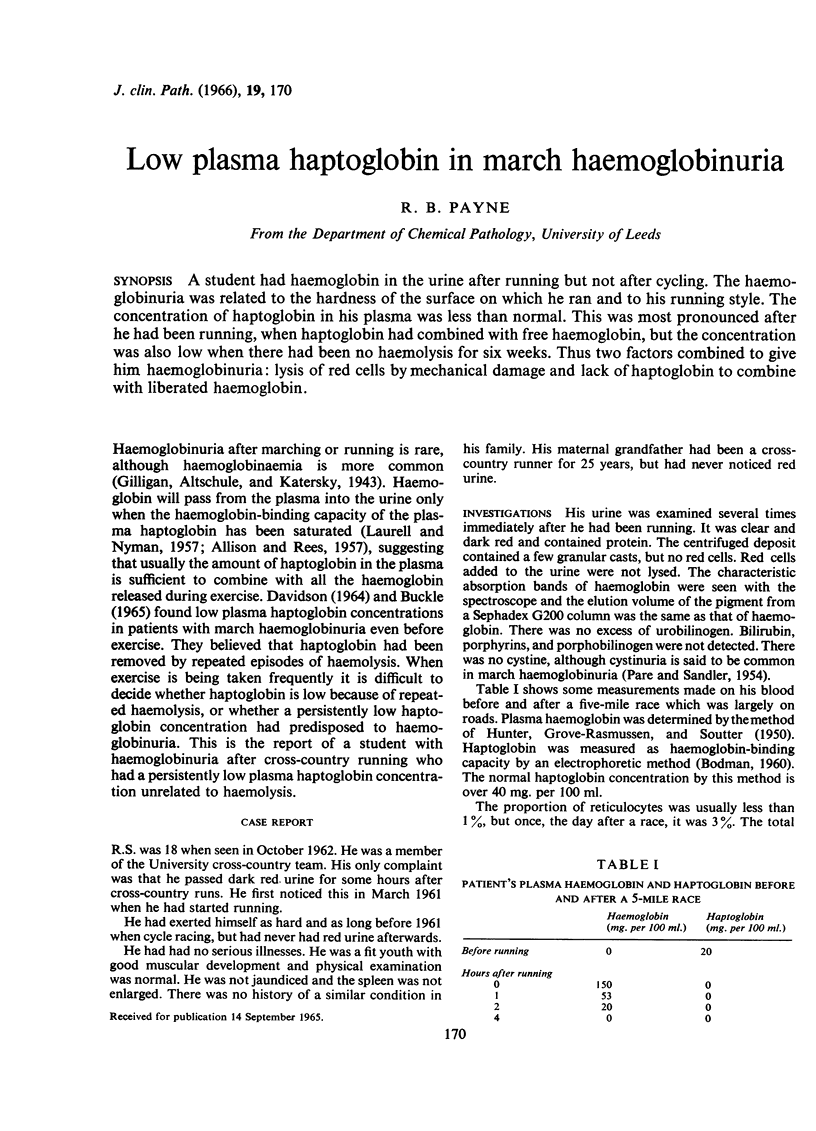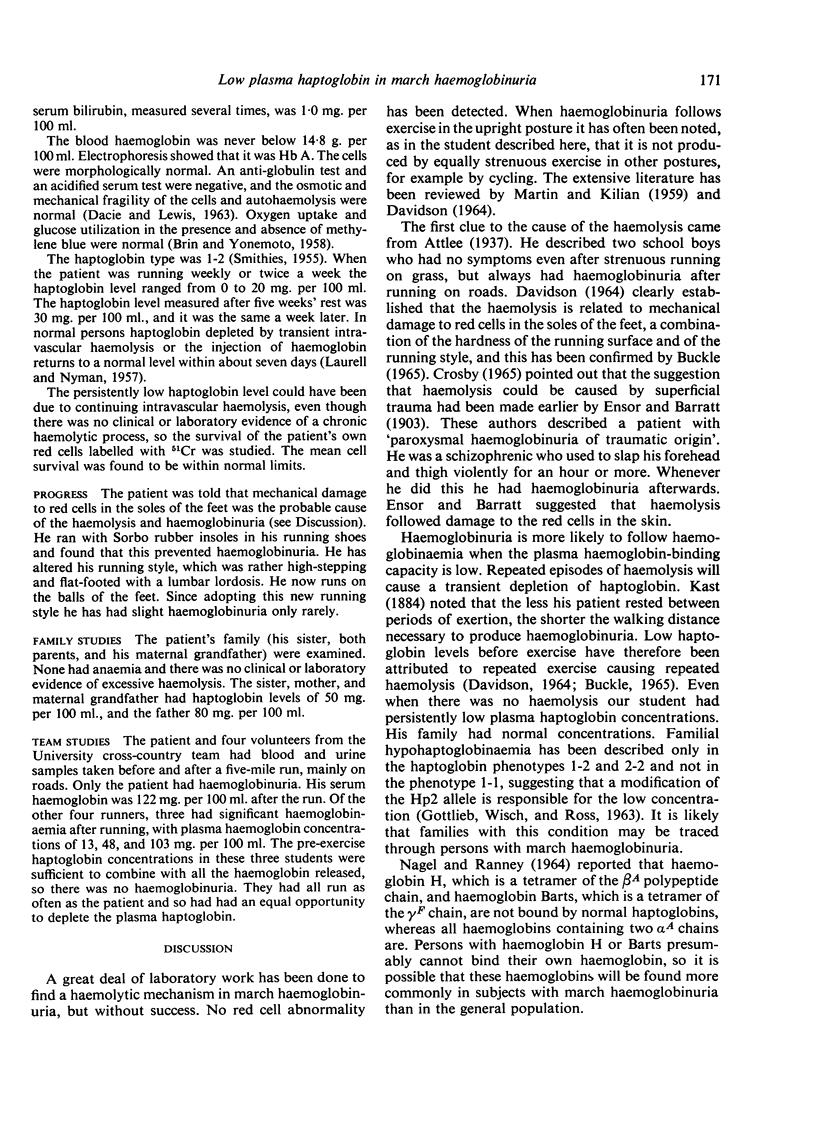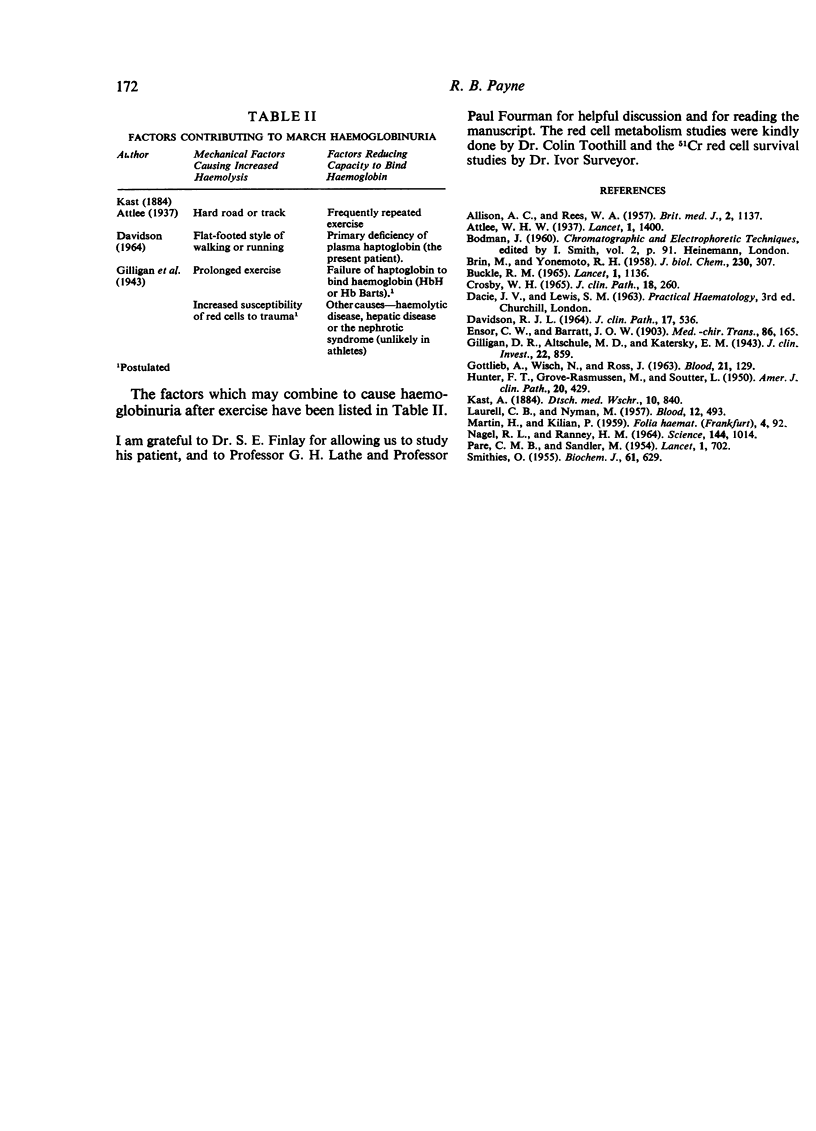Abstract
A student had haemoglobin in the urine after running but not after cycling. The haemoglobinuria was related to the hardness of the surface on which he ran and to his running style. The concentration of haptoglobin in his plasma was less than normal. This was most pronounced after he had been running, when haptoglobin had combined with free haemoglobin, but the concentration was also low when there had been no haemolysis for six weeks. Thus two factors combined to give him haemoglobinuria: lysis of red cells by mechanical damage and lack of haptoglobin to combine with liberated haemoglobin.
Full text
PDF


Selected References
These references are in PubMed. This may not be the complete list of references from this article.
- ALLISON A. C., REES W. A. The binding of haemoglobin by plasma proteins (haptoglobins); its bearing on the renal threshold for haemoglobin and the aetiology of haemoglobinuria. Br Med J. 1957 Nov 16;2(5054):1137–1143. doi: 10.1136/bmj.2.5054.1137. [DOI] [PMC free article] [PubMed] [Google Scholar]
- BRIN M., YONEMOTO R. H. Stimulation of the glucose oxidative pathway in human erythrocytes by methylene blue. J Biol Chem. 1958 Jan;230(1):307–317. [PubMed] [Google Scholar]
- BUCKLE R. M. EXERTIONAL (MARCH) HAEMOGLOBINURIA: REDUCTION OF HAEMOLYTIC EPISODES BY USE OF SORBO-RUBBER INSOLES IN SHOES. Lancet. 1965 May 29;1(7396):1136–1138. doi: 10.1016/s0140-6736(65)91958-6. [DOI] [PubMed] [Google Scholar]
- Crosby W. H. Letter to the Editor. J Clin Pathol. 1965 Mar;18(2):260–260. doi: 10.1136/jcp.18.2.260-b. [DOI] [PMC free article] [PubMed] [Google Scholar]
- DAVIDSON R. J. EXERTIONAL HAEMOGLOBINURIA: A REPORT ON THREE CASES WITH STUDIES ON THE HAEMOLYTIC MECHANISM. J Clin Pathol. 1964 Sep;17:536–540. doi: 10.1136/jcp.17.5.536. [DOI] [PMC free article] [PubMed] [Google Scholar]
- Ensor C. W., Barratt J. O. Paroxysmal Hæmoglobinuria of Traumatic Origin. Med Chir Trans. 1903;86:165–195. [PMC free article] [PubMed] [Google Scholar]
- GOTTLIEB A., WISCH N., ROSS J. Familial hypohaptoglobinemia. A genetically determined trait segragating from glucose-6-phosphate dehydrogenase deficiency. Blood. 1963 Feb;21:129–140. [PubMed] [Google Scholar]
- Gilligan D. R., Altschule M. D., Katersky E. M. PHYSIOLOGICAL INTRAVASCULAR HEMOLYSIS OF EXERCISE. HEMOGLOBINEMIA AND HEMOGLOBINURIA FOLLOWING CROSS-COUNTRY RUNS. J Clin Invest. 1943 Nov;22(6):859–869. doi: 10.1172/JCI101460. [DOI] [PMC free article] [PubMed] [Google Scholar]
- HUNTER F. T., GROVE-RASMUSSEN M., SOUTTER L. A spectrophotometric method for quantitating hemoglobin in plasma or serum. Am J Clin Pathol. 1950 May;20(5):429–433. doi: 10.1093/ajcp/20.5.429. [DOI] [PubMed] [Google Scholar]
- LAURELL C. B., NYMAN M. Studies on the serum haptoglobin level in hemoglobinemia and its influence on renal excretion of hemoglobin. Blood. 1957 Jun;12(6):493–506. [PubMed] [Google Scholar]
- MARTIN H., KILIAN P. [March hemoglobinuria (Studies on the mechanism of hemolysis and review of the literature)]. Folia Haematol (Frankf) 1959 Jul;4:92–117. [PubMed] [Google Scholar]
- NAGEL R. L., RANNEY H. M. HAPTOGLOBIN BINDING CAPACITY OF CERTAIN ABNORMAL HEMOGLOBINS. Science. 1964 May 22;144(3621):1014–1015. doi: 10.1126/science.144.3621.1014. [DOI] [PubMed] [Google Scholar]
- PARE C. M., SANDLER M. Amino-aciduria in March haemoglobinuria. Lancet. 1954 Apr 3;266(6814):702–704. doi: 10.1016/s0140-6736(54)92109-1. [DOI] [PubMed] [Google Scholar]
- SMITHIES O. Zone electrophoresis in starch gels: group variations in the serum proteins of normal human adults. Biochem J. 1955 Dec;61(4):629–641. doi: 10.1042/bj0610629. [DOI] [PMC free article] [PubMed] [Google Scholar]


